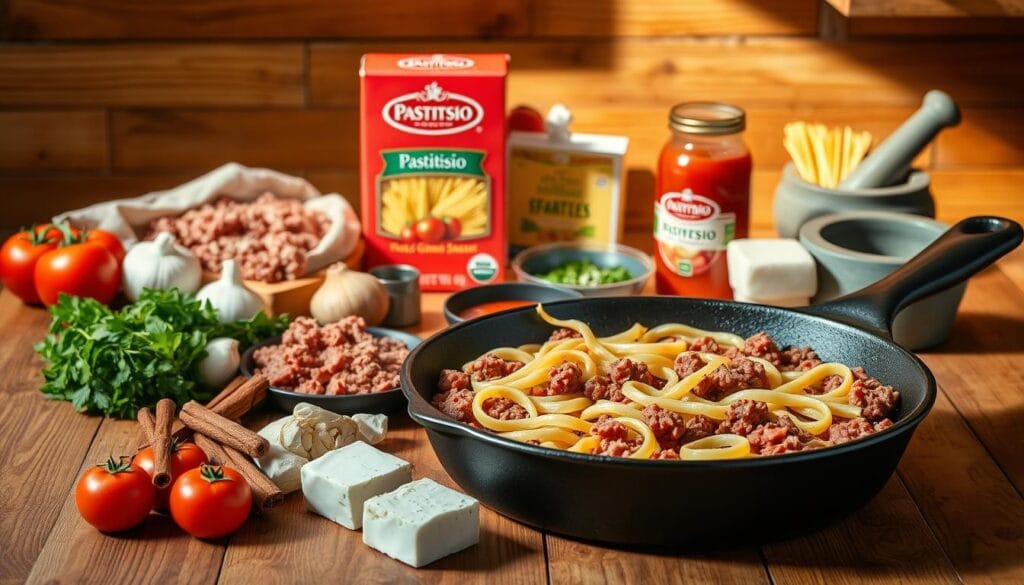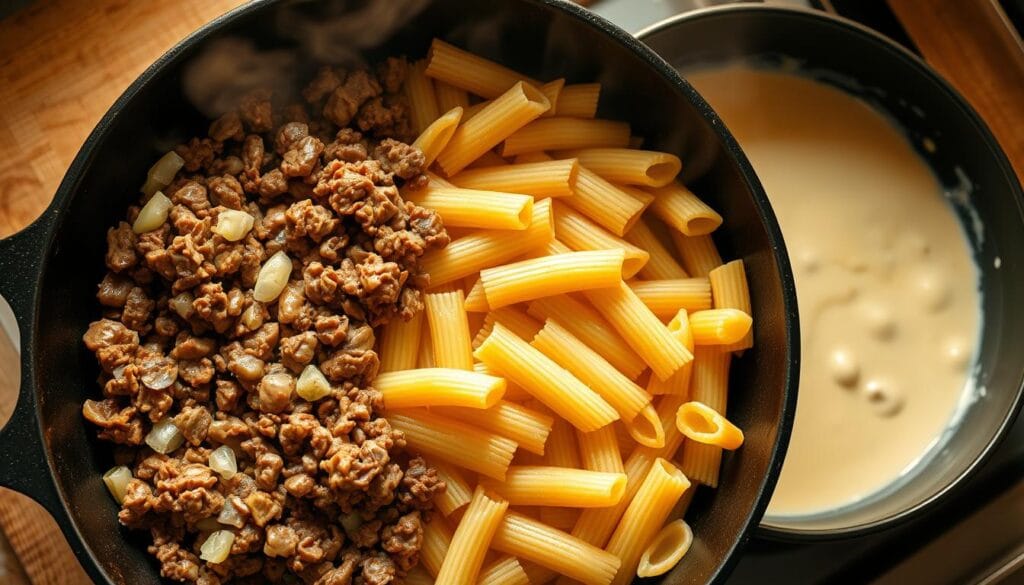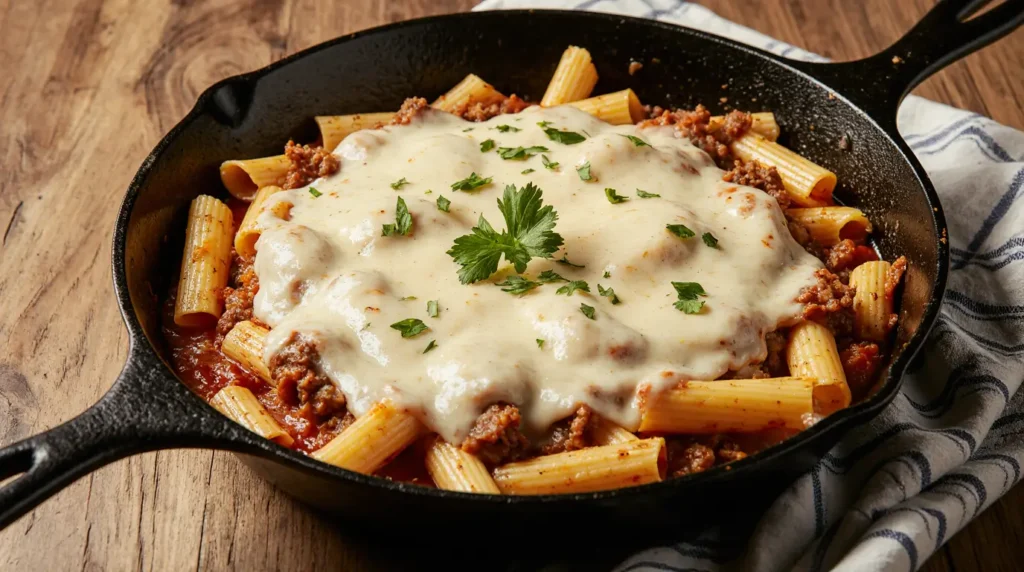When I first found Skillet Pastitsio, it felt like discovering a secret treasure from the Mediterranean. The smells of ground meat, pasta, and creamy béchamel sauce took me to a cozy Greek kitchen. It was all done without the long prep time of a traditional casserole.
This easy version of Greek cuisine brings Mediterranean comfort food right to your table. Skillet Pastitsio is a quick 30-minute meal that keeps the authentic flavors of the classic Greek dish. It’s a simplified way to enjoy a beloved Greek dish.
Imagine making a restaurant-quality Greek dish with little effort but lots of joy. Your kitchen will be filled with the warm, inviting smells of herbs, spices, and perfectly mixed ingredients. This one-pan meal is sure to become a family favorite.
Whether you’re an experienced cook or new to international dishes, Skillet Pastitsio is a great introduction to Greek cooking. It’s a delicious, easy way to impress your loved ones with a traditional Mediterranean classic.
Table of Contents
Understanding the Origins of Traditional Greek Pastitsio
Pastitsio is a beloved traditional Greek dish. It’s a key part of Mediterranean comfort food. This casserole has deep roots in Greek culinary history, telling a story of culture and tradition passed down through generations.
The story of this beloved dish goes back centuries. It shows the evolution of Greek cuisine. Pastitsio is a symbol of family and tradition, bringing people together.
Historical Roots of Greek Casseroles
Greek casseroles started from practical cooking. Families used pasta, meat, and creamy sauces to make big meals. These meals were efficient and could feed many.
- Ancient Greek influences on cooking techniques
- Adaptation of ingredients through different historical periods
- Migration’s impact on recipe development
Regional Variations Across Greece
Every Greek region has its own version of pastitsio. From mountains to coastlines, the dish reflects local traditions and ingredients.
| Region | Unique Characteristic |
|---|---|
| Thessaly | Heavier meat sauce |
| Crete | Additional local herbs |
| Macedonia | Spicier flavor profile |
Cultural Significance in Mediterranean Cuisine
Pastitsio is more than food—it’s a culinary storyteller. It shows Greek hospitality, family, and the joy of shared meals. These values are at the heart of Mediterranean food culture.
Knowing its origins helps us see why pastitsio is loved in Greek homes and restaurants around the world.
Essential Ingredients for Your Skillet Pastitsio

To make a real homemade skillet pastitsio, you need the right ingredients. These should capture the true taste of Greek cuisine. Start by picking the best ingredients to bring this dish to life.
For a classic skillet pastitsio, you’ll need a few key ingredients. They work together to make a dish that’s both rich and flavorful:
- Pasta: Thick bucatini or ziti noodles form the foundation of your dish
- Meat: Ground beef or lamb with traditional Greek seasonings
- Cheese: Kefalograviera or Parmesan for authentic Greek flavor
- Spices: Cinnamon, nutmeg, and oregano for distinctive Mediterranean taste
The secret to a great homemade skillet pastitsio is in the ingredients. Fresh ground meat, top-notch pasta, and real Greek cheeses make a big difference. They help you get the true spirit of this beloved Greek dish.
Got dietary restrictions? No worries! You can still make this dish:
- Substitute ground beef with plant-based meat alternatives
- Use gluten-free pasta for a celiac-friendly version
- Replace dairy cheese with vegan alternatives
Your aim is to make a tasty skillet pastitsio. It should honor traditional Greek cooking and fit your dietary needs.
Kitchen Tools and Equipment Needed
Preparing a tasty easy skillet recipe like pastitsio needs the right tools. The right equipment makes cooking your quick pastitsio recipe easy. This ensures a smooth cooking experience.
Choosing the right tools makes cooking more fun and efficient. Let’s look at the essential equipment for this classic Greek dish.
Selecting the Perfect Skillet
The key to a great easy skillet recipe is the skillet itself. For traditional pastitsio, consider these factors:
- Cast iron skillets (10-12 inches) are best for even heat
- Oven-safe skillets make stovetop-to-oven transitions easy
- Non-stick surfaces prevent ingredients from sticking
Essential Cooking Utensils
Your quick pastitsio recipe needs specific tools:
- Large wooden spoon for mixing
- Sharp chef’s knife
- Measuring cups and spoons
- Whisk for smooth béchamel sauce
- Grater for cheese
Time-Saving Kitchen Gadgets
Modern kitchen gadgets can make cooking faster. Consider these tools:
- Food processor for quick meat and veggie prep
- Digital kitchen scale for exact ingredient amounts
- Instant-read thermometer for meat doneness
With these tools, you’ll be ready to make a delicious and authentic pastitsio. It will impress your family and friends.
Step-by-Step Guide to Making Skillet Pastitsio

Making a tasty one-pan pastitsio is simple. This recipe brings Greek flavors to your kitchen with less cleanup and more taste.
Begin by getting your ingredients ready for the one-pan pastitsio. You’ll need:
- Ground beef or lamb
- Pasta (preferably bucatini or ziti)
- Tomato sauce
- Onions and garlic
- Spices like cinnamon and oregano
- Eggs and milk for the béchamel sauce
Start by browning the meat in a large cast-iron skillet. Drain the fat and add diced onions and minced garlic. Then, add traditional Greek spices for deep flavors.
Layer your pasta over the meat. Pro tip: Break the pasta into smaller pieces for even cooking. Pour tomato sauce over to keep it moist and tasty.
Make a creamy béchamel sauce for the top. Whisk eggs into the sauce for a rich, custardy texture. This turns your easy skillet recipe into a dish fit for a restaurant.
Bake the skillet pastitsio until the top is golden and crispy. Let it rest for 10-15 minutes before serving. This allows the layers to set perfectly.
Mastering the Perfect Béchamel Sauce
The béchamel sauce is key in Greek cuisine. It turns a simple dish into a traditional delight. This creamy sauce needs precision to get it just right.
Making a great béchamel sauce takes focus and skill. These techniques will boost your Greek cooking.
Classic Greek Béchamel Techniques
To make a true béchamel, follow these steps:
- Use high-quality butter for rich flavor
- Keep the heat low to medium while whisking
- Add milk slowly to avoid lumps
- Whisk constantly for a smooth sauce
Troubleshooting Common Sauce Issues
Even pros face béchamel challenges. Here are common problems:
- Lumpy sauce: Sift flour and whisk constantly
- Burnt bottom: Use low heat and stir often
- Too thin: Cook longer or add more flour
Making it Ahead and Storage Tips
You can make béchamel sauce ahead of time. Store it in an airtight container in the fridge for up to three days. When reheating, whisk gently and add a bit of milk to keep it creamy.
Tips for Achieving Authentic Greek Flavors
To make a real skillet pastitsio, you need to do more than just follow a recipe. It’s about understanding the small details of Mediterranean comfort food. And mastering a few key techniques.
Begin by picking the best, freshest ingredients for traditional Greek cooking. These are the basics of your flavor:
- Fresh herbs like oregano, mint, and parsley
- Extra virgin olive oil from Greece
- Authentic Greek cheeses such as kefalotyri or mizithra
- Robust spices like cinnamon and nutmeg
The trick to making your skillet pastitsio better is to layer flavors carefully. Greek cooking is all about balance and depth. So, take your time and let each ingredient shine before mixing them together.
Here are some expert tips for getting that true Mediterranean taste:
- Toast your spices briefly to release their aromatic oils
- Use room temperature ingredients for smoother mixing
- Let the dish rest for 10-15 minutes after cooking to enhance flavor integration
Real Greek cooking is about passion, tradition, and sharing. Your skillet pastitsio should share a story of Mediterranean comfort food. It should bring people together with its rich, vibrant flavors.
Serving Suggestions and Pairing Options
Your homemade skillet pastitsio is ready for a special dining experience. It’s time to show off its rich flavors and Greek heritage. Choose the right sides and presentation to make this dish unforgettable.
Delightful Greek Side Dishes
Pair your traditional Greek dish with these authentic sides:
- Greek salad with fresh horiatiki ingredients
- Roasted lemon-herb vegetables
- Tzatziki with warm pita bread
- Marinated olives and feta cheese
Wine and Beverage Pairings
Choose drinks that bring out the best in your homemade skillet pastitsio:
- Assyrtiko white wine from Santorini
- Agiorgitiko red wine from Nemea
- Ouzo as a traditional aperitif
- Sparkling mineral water with lemon
Presentation Tips for Special Occasions
Make your dining experience memorable with elegant presentation. Serve your skillet pastitsio straight from the cast-iron skillet for a rustic touch. Top it with fresh herbs like parsley or oregano. Use white ceramic plates to highlight the golden-brown dish.
For special events, add a sprinkle of crumbled feta or a drizzle of extra virgin olive oil just before serving. This will enhance both the look and taste of your traditional Greek dish.
Conclusion
Your journey into Skillet Pastitsio shows how Greek cuisine can be quick and easy. This dish brings Mediterranean flavors to your table with simple steps.
Learning to make Skillet Pastitsio is a great way to enjoy Greek food without spending hours cooking. It’s more than a recipe; it’s a way to celebrate Greek culture in your kitchen.
Whether it’s for a family dinner or a special event, this recipe is perfect. It adds depth and flavor that will wow your guests. You can now make a classic Greek dish with ease.
Enjoy cooking and let your creativity flow. Your Skillet Pastitsio is more than food; it’s a way to connect with rich traditions while keeping up with your busy life.




